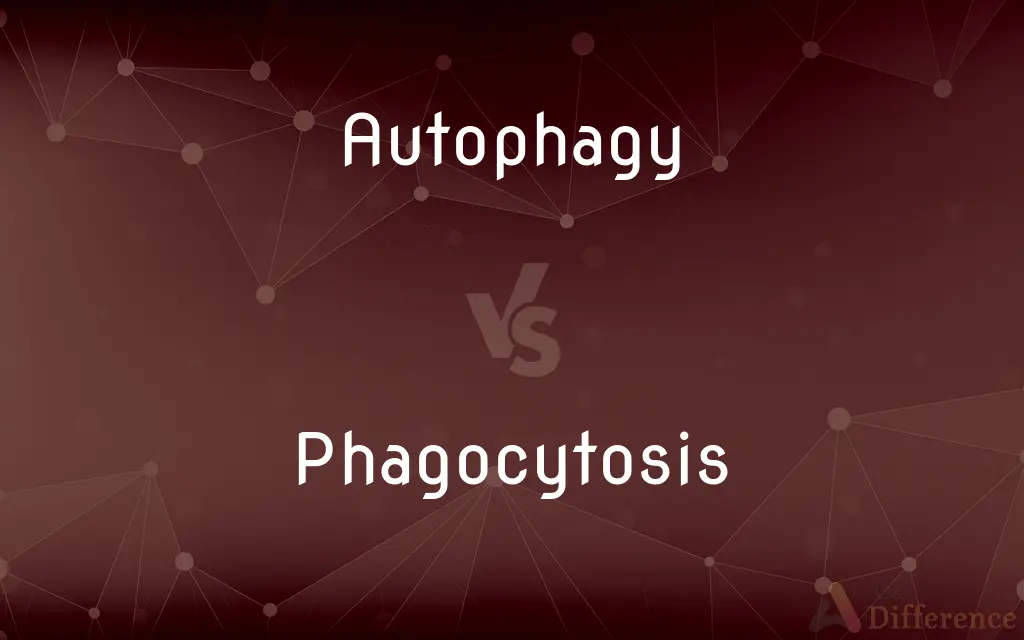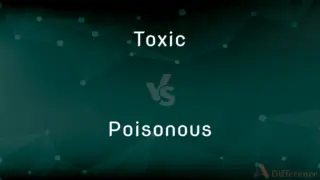Autophagy vs. Phagocytosis — What's the Difference?
By Tayyaba Rehman & Urooj Arif — Updated on March 30, 2024
Autophagy is a cell's process of recycling its own damaged components, while phagocytosis involves a cell engulfing external particles or microbes for destruction.

Difference Between Autophagy and Phagocytosis
Table of Contents
ADVERTISEMENT
Key Differences
Autophagy is a cellular mechanism crucial for homeostasis and survival, enabling cells to degrade and recycle their own damaged or unnecessary components. This process allows cells to maintain balance by removing defective parts and supplying new building blocks and energy. On the other hand, phagocytosis is a form of endocytosis where a cell engulfs large particles or microorganisms from its external environment, often for the purpose of defense or nutrition.
Autophagy involves the formation of double-membraned vesicles called autophagosomes, which enclose the cellular material to be degraded. These autophagosomes then fuse with lysosomes, where the enclosed material is broken down and recycled. In contrast, during phagocytosis, the cell membrane extends around the target particle or microbe, eventually enclosing it within a vesicle known as a phagosome. This phagosome then fuses with a lysosome, where its contents are digested.
The regulation of autophagy is complex, involving numerous signaling pathways that can be triggered by various conditions, including nutrient deprivation, oxidative stress, and infection. This ensures that cells can respond to stress and maintain their health and function. Conversely, phagocytosis is primarily initiated by the recognition of foreign particles, often marked by antibodies or complement proteins, indicating that it is closely linked to the immune response.
In terms of health implications, dysregulation of autophagy has been implicated in a range of diseases, including cancer, neurodegenerative disorders, and infections. Enhancing or inhibiting autophagy can have therapeutic potential. Phagocytosis' dysfunction, however, is often linked to impaired immune responses, leading to increased susceptibility to infections and the accumulation of cellular debris, which can contribute to inflammatory and autoimmune diseases.
Comparison Chart
Definition
Cellular process of degrading and recycling its own components
Cellular process of engulfing external particles or microbes
ADVERTISEMENT
Function
Maintains cellular homeostasis by recycling damaged parts
Protects against external threats and clears debris
Key Structures
Autophagosomes and lysosomes
Phagosomes and lysosomes
Regulation
Controlled by cellular stress signals and nutrient availability
Triggered by recognition of foreign particles
Role in Health
Implicated in cancer, neurodegeneration, and immune response
Essential for immune defense and tissue homeostasis
Compare with Definitions
Autophagy
It involves autophagosomes that fuse with lysosomes for degradation.
Autophagy degrades worn-out mitochondria to prevent cellular damage.
Phagocytosis
Phagocytosis is the engulfment of particles by cells for defense.
White blood cells use phagocytosis to destroy bacteria.
Autophagy
Autophagy can defend against pathogens by degrading them.
Autophagy helps eliminate intracellular bacteria, preventing infection.
Phagocytosis
Impaired phagocytosis leads to increased infection risk.
Some genetic disorders reduce phagocytic activity, leading to frequent infections.
Autophagy
Autophagy recycles damaged cellular components, ensuring cellular maintenance.
During starvation, cells use autophagy to recycle nutrients.
Phagocytosis
Triggered by the immune system's recognition of pathogens.
Antibodies coating a virus can initiate its phagocytosis.
Autophagy
Autophagy is regulated by nutrient levels and stress signals.
Nutrient deprivation triggers autophagy to sustain cellular energy levels.
Phagocytosis
Phagocytosis is crucial for clearing lost cells.
Macrophages phagocytose apoptotic cells to maintain tissue health.
Autophagy
Dysregulated autophagy is linked to diseases like cancer.
In cancer, altered autophagy can promote tumor survival.
Phagocytosis
Phagocytosis (from Ancient Greek φαγεῖν (phagein) 'to eat', and κύτος, (kytos) 'cell') is the process by which a cell uses its plasma membrane to engulf a large particle (≥ 0.5 μm), giving rise to an internal compartment called the phagosome. It is one type of endocytosis.
Autophagy
Autophagy (or autophagocytosis) (from the Ancient Greek αὐτόφαγος autóphagos, meaning "self-devouring" and κύτος kýtos, meaning "hollow") is the natural, conserved degradation lysosome-dependent regulated mechanism of the cell that removes unnecessary or dysfunctional components. It allows the orderly degradation and recycling of cellular components.
Phagocytosis
The engulfing and destruction of particulate matter, such as a bacterium, by a cell.
Autophagy
The process of self-digestion by a cell through the action of enzymes originating within the same cell.
Phagocytosis
A form of endocytosis in which a cell incorporates a particle by extending pseudopodia and drawing the particle into a vacuole of its cytoplasm.
Autophagy
(cytology) The process of self-digestion by a cell through the action of enzymes originating within the same cell. Often a defensive and/or self-preservation measure.
Phagocytosis
Process in which phagocytes engulf and digest microorganisms and cellular debris; an important defense against infection
Autophagy
(cytology) A type of programmed cell death accomplished through self-digestion.
Autophagy
(rare) Self-consumption; the act of eating oneself.
Autophagy
The feeding of the body upon itself, as in fasting; nutrition by consumption of one's own tissues.
Common Curiosities
How do autophagy and phagocytosis differ in their roles?
Autophagy primarily recycles internal cellular components, while phagocytosis focuses on eliminating external threats.
Can autophagy protect against infections?
Yes, autophagy can eliminate intracellular pathogens, aiding in immune defense.
What is autophagy?
Autophagy is a cellular process that degrades and recycles cellular components to maintain homeostasis.
How does phagocytosis contribute to immunity?
Phagocytosis directly eliminates pathogens and debris, playing a critical role in innate and adaptive immunity.
What structures are involved in autophagy?
Autophagosomes and lysosomes are key structures in the autophagic process.
What structures are involved in phagocytosis?
Phagocytosis involves the formation of phagosomes, which fuse with lysosomes for digestion.
How is autophagy regulated?
Autophagy is regulated by complex signaling pathways that respond to cellular and environmental cues.
What is phagocytosis?
Phagocytosis is a process where cells engulf and digest large particles or microorganisms, serving as a defense mechanism.
Can the dysfunction of autophagy lead to diseases?
Yes, dysregulation of autophagy is linked to various diseases, including cancer and neurodegenerative disorders.
What is the relationship between autophagy and aging?
Autophagy is thought to play a protective role in aging, helping to clear damaged components that could lead to cellular dysfunction.
What triggers autophagy?
Autophagy is triggered by various stress signals, including nutrient deprivation, oxidative stress, and infection.
Can autophagy occur in all types of cells?
Autophagy is a fundamental process that occurs in almost all eukaryotic cells.
How do cells recognize what to engulf during phagocytosis?
Cells recognize targets for phagocytosis through surface markers like antibodies or complement proteins.
Is phagocytosis only performed by specific cells?
While many cells can perform phagocytosis to some extent, it is primarily associated with specialized immune cells like macrophages and neutrophils.
Share Your Discovery

Previous Comparison
Toxic vs. Poisonous
Next Comparison
Meat vs. MuttonAuthor Spotlight
Written by
Tayyaba RehmanTayyaba Rehman is a distinguished writer, currently serving as a primary contributor to askdifference.com. As a researcher in semantics and etymology, Tayyaba's passion for the complexity of languages and their distinctions has found a perfect home on the platform. Tayyaba delves into the intricacies of language, distinguishing between commonly confused words and phrases, thereby providing clarity for readers worldwide.
Co-written by
Urooj ArifUrooj is a skilled content writer at Ask Difference, known for her exceptional ability to simplify complex topics into engaging and informative content. With a passion for research and a flair for clear, concise writing, she consistently delivers articles that resonate with our diverse audience.














































